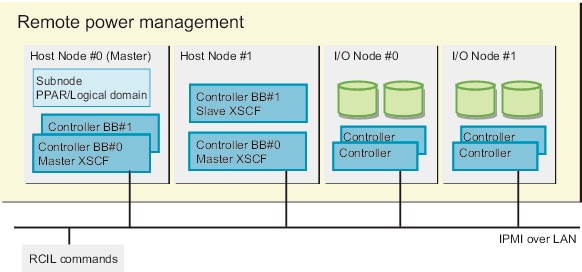14.6.1 Remote Power Management Function for the SPARC M12/M10
14.6.1 Remote Power Management Function for the SPARC M12/M10
The remote power management function for the SPARC M12/M10 system (Remote Cabinet Interface over LAN: RCIL) is an interface which controls the remote power management function for the power supply between SPARC M12/M10 systems or I/O devices. RCIL employs a proprietary interface based on IPMI over LAN. If the following functions of general IPMI are supported, RCIL can be set as the target of remote power management without regard to differences in the controlled hardware or operating systems. RCIL uses the XSCF-LAN on the SPARC M12/M10.
- Power on and off: Chassis Control
- Obtaining power supply status: Get Chassis Status
Table 14-13 shows the terms and definitions that are used with the remote power management function for the SPARC M12/M10.
| Term | Definition |
|---|---|
| Host node | Server that supports the remote power management function for the SPARC M12/M10 systems. All models of the SPARC M12/M10 support the remote power management function. |
| Master host node | Host node that is set as the master when setting a remote power management group. The master host node is a host node that monitors connections with other host nodes and I/O nodes. |
| Subnode | Physical partition in the SPARC M12/M10 |
| I/O node | I/O device, such as the ETERNUS, or remote power distribution unit that supports the remote power management function for the SPARC M12/M10 |
| Remote power management group | Group obtained from the grouping of remote power management targets, such as a host node, subnode, and I/O node. A unique group ID is assigned to a remote power management group. |
| Controller | Mechanism to control the remote power management function. A controller needs to be mounted in each node. In the SPARC M12/M10, the XSCF is a controller. |
If the remote power management function is used, create a remote power management group in combination with power-interlocked nodes. You can control remote power management per created remote power management group.
| Note - Each host node, subnode, or I/O node can be set in only one remote power management group. |
|
Figure 14-5 Example of a Remote Power Management Group of the SPARC M12/M10
|

|
< Previous Page | Next Page >